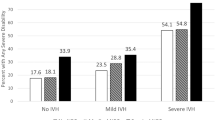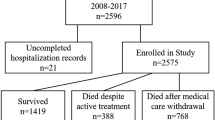Abstract
Objective:
We sought to determine the incidence of necrotizing enterocolitis (NEC) and spontaneous intestinal perforation (SIP) in surviving extremely low-birth-weight (ELBW, <1000 g birth weight) infants and to establish the impact of NEC on outcomes by hospital discharge and at 18 to 22 months adjusted age in a large, contemporary, population-based practice.
Study Design:
Hospital outcome data for all ELBW infants born in the greater Cincinnati region from 1998 to 2009 were extracted from the National Institute of Child Health Neonatal Research Network Database. Neurodevelopmental outcome at 18 to 22 months was assessed using Bayley Scales of Infant Development-II scores for Mental Developmental Index and Psychomotor Developmental Index. Multivariable logistic regression was used and adjusted odds ratios reported to control for confounders.
Result:
From 1998 to 2009, ELBW infants accounted for 0.5% of the 352 176 live-born infants in greater Cincinnati. The incidence of NEC was 12%, with a 50% case-fatality rate. Death before discharge, morbid complications of prematurity and neurodevelopmental impairment were all increased among infants diagnosed with NEC. Infants with surgical NEC and SIP had a higher incidence of death, but long-term neurodevelopmental outcomes were not different comparing surviving ELBW infants with medical NEC, surgical NEC and SIP.
Conclusion:
Although ELBW infants comprise a very small proportion of live-born infants, those who develop NEC and SIP are at an increased risk for death, morbid complications of prematurity and neurodevelopmental impairment. No significant differences in neurodevelopmental outcomes were observed between the medical and surgical NEC and SIP groups.
This is a preview of subscription content, access via your institution
Access options
Subscribe to this journal
Receive 12 print issues and online access
$259.00 per year
only $21.58 per issue
Buy this article
- Purchase on Springer Link
- Instant access to full article PDF
Prices may be subject to local taxes which are calculated during checkout

Similar content being viewed by others
References
Guthrie SO, Gordon PV, Thomas V, Thorp JA, Peabody J, Clark RH . Necrotizing enterocolitis among neonates in the United States. J Perinatol 2003; 23 (4): 278–285.
Henry MC, Moss RL . Necrotizing enterocolitis. Annu Rev Med 2009; 60: 111–124.
Fanaroff AA, Wright LL, Stevenson DK, Shankaran S, Donovan EF, Ehrenkranz RA et al. Very-low-birth-weight outcomes of the National Institute of Child Health and Human Development Neonatal Research Network, May 1991 through December 1992. Am J Obstet Gynecol 1995; 173 (5): 1423–1431.
Fanaroff AA, Stoll BJ, Wright LL, Carlo WA, Ehrenkranz RA, Stark AR et al. Trends in neonatal morbidity and mortality for very low birthweight infants. Am J Obstet Gynecol 2007; 196 (2): 147 e1–8.
Stoll BJ, Hansen NI, Bell EF, Shankaran S, Laptook AR, Walsh MC et al. Neonatal outcomes of extremely preterm infants from the NICHD Neonatal Research Network. Pediatrics 2010; 126 (3): 443–456.
Simpson CD, Ye XY, Hellmann J, Tomlinson C . Trends in cause-specific mortality at a Canadian Outborn NICU. Pediatrics 2010; 126 (6): e1538–e1544.
Hintz SR, Kendrick DE, Stoll BJ, Vohr BR, Fanaroff AA, Donovan EF et al. Neurodevelopmental and growth outcomes of extremely low birth weight infants after necrotizing enterocolitis. Pediatrics 2005; 115 (3): 696–703.
Schulzke SM, Deshpande GC, Patole SK . Neurodevelopmental outcomes of very low-birth-weight infants with necrotizing enterocolitis: a systematic review of observational studies. Arch Pediatr Adolesc Med 2007; 161 (6): 583–590.
Hunter CJ, Chokshi N, Ford HR . Evidence vs experience in the surgical management of necrotizing enterocolitis and focal intestinal perforation. J Perinatol 2008; 28 (Suppl 1): S14–S17.
Gordon PV, Attridge JT . Understanding clinical literature relevant to spontaneous intestinal perforations. Am J Perinatol 2009; 26 (4): 309–316.
Gordon PV . Understanding intestinal vulnerability to perforation in the extremely low birth weight infant. Pediatr Res 2009; 65 (2): 138–144.
Adesanya OA, O′Shea TM, Turner CS, Amoroso RM, Morgan TM, Aschner JL . Intestinal perforation in very low birth weight infants: growth and neurodevelopment at 1 year of age. J Perinatol 2005; 25 (9): 583–589.
Stevenson DK, Wright LL, Lemons JA, Oh W, Korones SB, Papile LA et al. Very low birth weight outcomes of the National Institute of Child Health and Human Development Neonatal Research Network, January 1993 through December 1994. Am J Obstet Gynecol 1998; 179 (6, Part 1): 1632–1639.
Walsh MC, Kliegman RM . Necrotizing enterocolitis: treatment based on staging criteria. Pediatr Clin North Am 1986; 33 (1): 179–201.
Amiel-Tison C, Stewart A . Follow up studies during the first five years of life: a pervasive assessment of neurological function. Arch Dis Child 1989; 64 (4 Spec No.): 496–502.
Palisano R, Rosenbaum P, Walter S, Russell D, Wood E, Galuppi B . Development and reliability of a system to classify gross motor function in children with cerebral palsy. Dev Med Child Neurol 1997; 39 (4): 214–223.
Russell DJ, Avery LM, Rosenbaum PL, Raina PS, Walter SD, Palisano RJ . Improved scaling of the gross motor function measure for children with cerebral palsy: evidence of reliability and validity. Phys Ther 2000; 80 (9): 873–885.
Bayley N . Bayley Scales of Infant Development, 2nd edn. The Psychological Corporation: San Antonio, TX, 1993.
Bayley N . Bayley Scales of Infant Development, 3rd edn. PsychCorp: San Antonio, TX, 2006.
Lee SK, McMillan DD, Ohlsson A, Pendray M, Synnes A, Whyte R et al. Variations in practice and outcomes in the Canadian NICU network: 1996–1997. Pediatrics 2000; 106 (5): 1070–1079.
Fellman V, Hellstrom-Westas L, Norman M, Westgren M, Källén K, Lagercrantz H et al. One-year survival of extremely preterm infants after active perinatal care in Sweden. JAMA 2009; 301 (21): 2225–2233.
Bhandari V, Bizzarro MJ, Shetty A, Zhong X, Page GP, Zhang H et al. Familial and genetic susceptibility to major neonatal morbidities in preterm twins. Pediatrics 2006; 117 (6): 1901–1906.
Morrow AL, Meinzen-Derr J, Huang P, Schibler KR, Cahill T, Keddache M et al. Fucosyltransferase 2 (FUT2) non-secretor and low secretor status predict severe outcomes in premature infants. J Pediatr 2010; 158 (5): 745–751.
Cotten CM, Taylor S, Stoll B, Goldberg RN, Hansen NI, Sánchez PJ et al. Prolonged duration of initial empirical antibiotic treatment is associated with increased rates of necrotizing enterocolitis and death for extremely low birth weight infants. Pediatrics 2009; 123 (1): 58–66.
Christensen RD, Gordon PV, Besner GE . Can we cut the incidence of necrotizing enterocolitis in half—today? Fetal Pediatr Pathol 2010; 29 (4): 185–198.
Acknowledgements
We thank the following individuals and hospital staff who contributed to this research: Eunice Kennedy Shriver NICHD NRN administrator (Estelle Fischer) and research coordinators and staff: (Kate Bridges, Cathy Grisby, Jody Hessling, Lenora Jackson, Kristin Kirker, Holly Mincey, Greg Muthig, Stacie Tepe). The NICU staffs at Cincinnati Children's Hospital Medical Center, Good Samaritan Hospital and University Hospital, Cincinnati. This work was supported in part by a grant from the National Institute of Child Health and Human Development Eunice Kennedy Shriver Neonatal Research Network (U10 HD 027853).
Author information
Authors and Affiliations
Corresponding author
Ethics declarations
Competing interests
The authors declare no conflict of interest.
Rights and permissions
About this article
Cite this article
Shah, T., Meinzen-Derr, J., Gratton, T. et al. Hospital and neurodevelopmental outcomes of extremely low-birth-weight infants with necrotizing enterocolitis and spontaneous intestinal perforation. J Perinatol 32, 552–558 (2012). https://doi.org/10.1038/jp.2011.176
Received:
Revised:
Accepted:
Published:
Issue Date:
DOI: https://doi.org/10.1038/jp.2011.176



